




By Roger Turner
On August 16th, the Miller Orchards’ “packing house,” crucial to orchard operations, history, and identity, was engulfed by flames. When the fire was finally extinguished, the sugaring arch, normally a receptacle of intense heat, was all that could withstand the intense heat of the fire, and alone remained standing above the sprawling, burned ruins. “Our farm lost our main operations building to fire on the afternoon of August 16th. Everyone is safe. The Miller family thanks the many firefighters and responders who risked their safety to contain the massive three alarm fire,” the Millers posted on their website.
The state police fire inspector was unable to come up with any determination about the fire’s cause and has left it “undetermined,” Dummerston Fire Chief Larry Pratt Jr. reported. “There was so much heat and damage that it’s really hard to pull an investigation together,” he explained.
Post Oil Solutions, operator of the Winter Brattleboro Farmers Market, immediately set up a GoFundMe appeal. “Dwight Miller Orchards has been a dedicated and much-loved member of both the Brattleboro Area Farmers Market in the summer and the Brattleboro Winter Farmers’ Market from the very beginning. And the Miller family has been farming on the same land longer than Vermont has been a state,” the nonprofit’s community organizer Sherry Maher wrote in the GoFundMe appeal. When the appeal ended in August, $98,587 had been raised.
The fire was devastating for the Millers. “Yeah, it’s very unfortunate, and it couldn’t have happened at a worse time of year for them. It was unfortunate for the entire community. They do a lot for the Apple Pie Festival, too,” Chief Pratt reflected.
Martha Miller Grace, daughter of Read and Malah, and granddaughter of Dwight and Gladys, has compiled a touching remembrance of how the building came into being, and what it has meant to the family. See related stories on page 13.
Dan Ridlehoover
As an organization, the West Dummerston Volunteer Fire Department has been continuously focused on moving forward. Since the department’s founding in 1950, there have been continuous improvements in process, refinements of policies, increases in training, and the adoption of new technologies. Members have earned new certifications, taken up new responsibilities, and call volumes have gone up.
While there is comfort in the constant march of progress, when crossing major milestones, there is something to be said for the importance of pausing to look back and appreciate where you came from and where you are today. This year marks the 75th anniversary since the creation of the West Dummerston Volunteer Fire Department and as an organization we have taken advantage of this moment for reflection, to make some changes for the future, and to record and acknowledge our past.
Effective July 1, 2025, the department officially changed its name to the Dummerston Fire Department, dropping ‘West’ as well as ‘Volunteer’ from our name. The change will largely be symbolic and there will be no change in our structure, locations, response areas, or other functions. We remain as 100% unpaid volunteers. Outwardly, you may notice that we have re-lettered our newer fire apparatus and updated the station signs. We’ll slowly work through a transition period of updating other “branded” items such as turnout gear continued on page 3
The Views of Dummerston is a quarterly newsletter published by a group of citizen volunteers since 1990, and has non-profit status through the Dummerston Community Center. Mary Lou McBean had the original vision for and was first editor of the Views, and Gary Blomgren created the original masthead art. The current steering committee includes Roger Turner (editor), Michelle Cherrier (co-articles coordinator and calendar), Fred Lee (layout), Sara Ryan (ad coordinator), Linda Rood (co-articles coordinator), and Lee Ives Tice (mailing). We always welcome new interest in joining the committee.
SUBSCRIPTIONS:
The Views is mailed free of charge to all residents of the town of Dummerston. It is also available online at viewsofdummerston.org. We encourage people to help us save printing and mailing expenses by cancelling their print subscription and accessing the Views online at viewsofdummerston.org; to do so please email Sara Ryan at: subscribe online@viewsofdummerston.org. If you are not a resident of Dummerston and would prefer to receive a paper copy of the Views, you may subscribe for an annual cost of $5. Mail a check made payable to Views of Dummerston, with your name and mailing address to Lee Tice, 230 School House Rd., East Dummerston, VT 05346.
ARTICLES:
We welcome all articles related in any way to the town of Dummerston, including news of town organizations, personalities, history, or activities. Email Microsoft Word documents (preferred) to: articles@viewsof dummerston.org. Typed or hand-written articles can also be sent to: Michelle Cherrier, 72 Miller Rd., East Dummerston, VT 05346.
CALENDAR:
Any (non-commercial) event you would like listed on our Calendar of Events should be emailed to: calendar@ viewsofdummerston.org, or mailed to Michelle Cherrier at the above address.
NEXT ISSUE:
Submissions due: January 6, 2026
Views will be mailed on: February 18, 2026
ADVERTISING:
Rates: All rates are for four issues, however a large or small box ad can be placed for just one issue at an adjusted rate. Payment should be by a check made out to the Views of Dummerston, and mailed to: Sara Ryan, 53 Greenhoe Rd., East Dummerston, VT 05346 Small Box Ad $60 Large Box Ad $90 Information/Inquiries: Contact Sara Ryan at: ads@ viewsofdummerston.org, or at 387-0110.
SPONSORSHIPS:
Sponsorships of $30 for four issues augment our ad revenues to provide us with operating funds. You will be notified when your sponsorship is up and invited to renew. If you wish to become a sponsor or have questions, contact Sara Ryan as above.
Digital Views available
Featuring easy navigation, clickable links, and full color. We’re sure you’ll love it! viewsofdummerston.org
Recorded and televised by BCTV and online at www.brattleborotv.org. (Select “Watch”, select “Watch On Demand”, select “Playlist”, scroll to “Dummerston”, select meeting.)
By Roger Turner
Some people live in Dummerston and think of it as their home because they were born here or somewhere nearby, and have an inborn sense that Dummerston is where they want and are meant to live. Others move to Dummerston, and over time develop that affection for and identification with the town. Ruth Houghton Barton, was born here and with husband Merrill Barton lived in her grandparents’ house on Houghton Road. She could trace her lineage back generations to the founding of Dummerston in the 1700s, as she was known to quite emphatically proclaim in town meetings to add special emphasis and authority to her opinions. Lew Sorenson and wife Gail, on the other hand, moved to the area when Lew took the job of executive director of the Windham Regional Commission. Though originally from the Midwest and after living around the country while working in various city planning jobs, Lew and Gail came to think of Dummerston as their home, both becoming very involved in town activities. It’s where Lew lived out his life.
Here are stories of two people who for different reasons thought of Dummerston as their home.

By Roger Turner
Lew was born in LaPorte, IN and went by his given first name of “Colonel” (after his paternal grandfather) until moving to Vermont in 1987 when he began introducing himself to everyone as “Lew”. With a major in Community Development at the University of Wisconsin-Madison, he began an itinerant career in city planning, first in the city of Madison, then in St. Paul, MN, San Luis Obispo, CA and Friday Harbor, WA. In 1988 he accepted an offer for the job of executive director of the Windham Regional Commission (WRC) here in Brattleboro, where he continued on page 15
Views

By Sallie J. May
On August 8, 2025, Dummerston lost one of the strongest women I have ever known, and I lost a really good friend. I have known Ruth Houghton Barton for about 72 years, first meeting her when I was about seven or eight. My family moved to Dummerston in the late 40s, and I started attending church here when I was about six, and where Ruth also attended and went to Sunday School. At the time her family lived with her grandparents on the continued on page 15
Providing reports of town organizations, and stories of townspeople and their good deeds, in promoting cooperation and understanding toward creating a more “ideal” Dummerston. “All who read may also contribute!”—Mary Lou McBean, founder, Views of Dummerston
By Todd Davidson
The selectboard and other interested parties have been considering ways to optimize the use and maintenance of the Dummerston Community Center in West Dummerston. This town-owned building has historically been leased for a nominal fee to the volunteerrun Dummerston Community Center (DCC) Board, who in turn has rented space (in the two smaller front rooms of the Center) to the Lydia Taft Pratt (LTP) Library. Most funding for the everyday operating and maintenance costs of the building comes from rent paid by the library, supplemented by fees and donations from group events held in the large community room at the back of the building. With the DCC board looking to take a less active role, and the library looking to expand its operations, the
time is ripe to take a close look at how various duties and costs should best be allocated for this valuable community resource.
To address the future of the DCC, working group meetings will be held through the end of the year and are open to the public. Participants will include the selectboard, the LTP Board of Trustees, Lydia’s Friends (a volunteer group supporting the library), and the DCC Board. One possibility that will be examined is turning over the management of the building to a new group, which would likely include library-related representatives. Instead of the current multi-level rentals, the working group will consider other financial arrangements, such as putting the library’s current budget line item funding into a town-managed account, from which the group managing the Community Center could draw through
continued from page 1 and equipment as those items are replaced on their original schedule.
Beyond the logistics of changing our name, the decision was complicated within the department. Some felt strongly that the significance of a 75-year-old name should be retained and abandoning it was disrespectful of history. Others felt that the inclusion of ‘West’ was confusing for newer community members who didn’t know the department’s origin story (more on this below). We know that other community members also may have strong opinions one way or another.
To act in balance with our decision for “progress,” we also decided that it was important to more actively serve as the stewards of our organization’s history. To assist in that effort, we’ve enlisted the help of the Dummerston Historical Society. We are grateful for their eagerness and support in capturing our story and history. Beginning on Sunday, October 5, the Historical Society began presenting an exhibit, running through the end of the year, which features the stories and artifacts from
75 years of the West Dummerston Volunteer Fire Department existence. The exhibition will be open on the first and third Sundays of each month. The Historical Society’s October quarterly meeting featured past and present fire fighters who through the stories they told gave a firsthand history of the fire department.
As always, we appreciate your support. We’re proud to have been a part of the community for the last 75 years and continue to look forward to the future.

warrant requests. The public is welcome to attend the group sessions.
Town FY27 Budget Working Sessions Budget working sessions began in September 2025 and will go through the end of the year.
We meet every other Wednesday in the town office at 6 p.m. The selectboard will post working documents on the town website after each meeting.
The Dummerston Listers would love to talk to any resident who would be interested in learning more about the duties of being a paid lister. Dummerston has three listers, each elected for a three-year term. We meet Tuesday and Thursday mornings from 9-12 at the town office, great hours for retirees or parents with school-age children! Please call (802) 257-1496 or stop by during working hours if you would like to learn more.
Shawn Bracebridge, pastor Office 257-0544 • Home 802-689-0753 www.facebook.com/DummerstonChurch

Linda Rood & Roger Turner
Nick & Joan Thorndike
Martha & Mitch Momaney
Marcy Hermansader
Lou Nelson
Allan & Sally Seymour

802-451-1941 www.PatientSympatheticCoaching.com
By Christine Goepp
The Conservation Commission has been focusing on public land recently. You may have noticed a new feature at the center of town: a “Conservation Station” built by Lew Teich, with help from commissioner Jesse Wagner and modeled on a concept originally conceived of by Rick Mills, who has since moved on to other projects. Lew’s handiwork is amazing! Inside are books and other materials relating to nature and conservation, available to borrow and read. Just please return or replace them when you’re done. There are so many wonderful nature writers out there right now: Tallamy, Kingsolver, Tapper, and countless others. We had
to share. And if you find something conservation-related that you think others would enjoy, please feel free to drop it off.
A few yards from the Conservation Station,

lew teich, a member of the Conservation Commission, has built an artistic “Conservation station,” installed next to the town office parking lot, which contains materials about nature and conservation to take on loan.
John Anderson & Noreen Cooper
John & Karen Abel
Roberta Garland
Orly Munzing & Bob Dunbar
Mark and Lee Tice
Fred Lee


next to the Historical Society Schoolhouse, is a new flower bed. The Conservation Commission accepted these free plants on behalf of the town from the Windham County Natural Resources Conservation District, who had them left over after their annual sale. We gathered up the bare root bags at Green Mountain Orchards, potted them up until they grew to a decent size, and then, with help from Phil Goepp

and Michelle Cherrier, planted them in the pouring rain. Then, of course, the rain stopped! But these are good tough plants, like agastache and coreopsis, so they sailed through the drought with no problem. (We think there may also be a watering fairy somewhere on the premises.)
Commissioners Bill Conley and Lew Teich helped Cory Ross and Isabel Bowman from the Conservation District install a new informational sign about the new rainwater infiltration upgrades at the covered bridge (which includes the steps). They also planted some handsome native shrubs, purchased at Nasami nursery, to help stabilize and beautify the bank there. So many people are enjoying the safe access to the beach. Every time I go there, I end up chatting with visitors, either local or sightseeing from other places. Today there were two visitors from England and a youth group enjoying the last of the warm summer sun!
john & Lori BruneLLe 416 Tucker reed road e. dummersTon, vT 05346
office fax: (802) 254-5818
office phone: (802) 254-9788
john ceLL: (802): 579-9788
Lori ceLL: (802) 275-7111
john@BruneLLeandson.com
Lori@BruneLLeandson.com www.BruneLLeandson.com
Bruce & Catie Berg
Gail & Lew Sorenson
David & Nina Hutchison
Kevin & Sara Ryan
John & Sheila Pinkney
JoAnn Tier
Lastly, David Greenewalt, Jesse Wagner, and I recently hiked to the top of Prospect Hill to assess what maintenance might be needed up there. We were pleasantly surprised to find the meadow in surprisingly good shape considering the drought. There were swaths of native little bluestem grass in flower, lit up by the lowering sun, large patches of blueberries, only a foot or so tall after last year’s mowing, and steeplebush poking up out of the blueberry just like its namesake. Mount Snow was easily visible to the west, and Monadnock to the east. During our walk, I learned how to identify spicebush (it’s growing near the little bridge) by crushing its leaves and smelling the spicy fragrance. A few buckthorn saplings and honeysuckle bushes need removing, and there is bittersweet growing around the bench at the top. Down along the treeline, a sizable clump of monoculture buckthorn may even require chemical control. A work day is definitely in the offing. But it is a beautiful spot, particularly at this time of year. We recommend a hike—park at the town office or the church and then walk up Park Laughton Road to the trailhead on your left.
By Catie G. Berg
Firewood comes to mind as the temperature drops! So many in Dummerston rely on wood for warmth. As fall proceeds, there’s no better time to think about the members of the Dummerston Church Wood Pantry. We salute them as the volunteers of this season! While they warm homes, they also warm our hearts.
A dozen years ago, Charlie Richardson, a retired forester, learned about some loggers in Haverhill, NH who were stocking wood for folks in financial need. Charlie liked that idea as a way to help folks in Dummerston who were financially stretched.
Charlie ran his idea by Don Hazelton (1930–2024), a legendary farmer, and Merrill Barton, a mechanical wizard. Typical of rural Vermonters, they’d do what they could to help.
They knew wood! They’d spent a lifetime managing their wood lots and stacking firewood to burn against the cold. They knew that some folks stacked extra wood; some loggers could spare a log; some homeowners needed a tree removed; other folks would report newly-downed trees available for the taking. As important as knowing wood, they knew how to find wood.
They went to work on a plan to stock cordwood. They called their enterprise the Wood Pantry and engaged the Dummerston Congregational Church as the conduit for this service. Whether promoted through the church’s newsletter, The Dummerstonian, by the minister, Reverend Shawn Bracebridge, or by word of mouth, the Wood Pantry started getting requests for its free firewood.
After a few years, Cliff Bergh, who had worked years before as a logger, joined the effort. The stamina of this team could challenge people half their age! Merrill loved “bulling and jamming” as he flexed his muscles with the tasks. Cliff discovered that he’d do his share of hefting, as the youngest hand. Charlie said

glabach@yahoo.com


that they all got along. “Nobody was the boss. We enjoyed working together.” Don had said that the task gave them a purpose bigger than themselves.
With a tractor, a pickup and a dump truck, chain saws, a splitter, brute strength, and brain strength through the laws of physics, “What couldn’t they accomplish?” Charlie’s wife, Bess, said. “They worked in rain, sleet, and snow -- just like the legendary postal carriers.”
What’s next for the Wood Pantry? Cliff said that it’s winding down as the team ages and as other resources for fuel are duplicating the Pantry’s services. Cliff continued, “We have obligations this fall, before the snow flies. There’s wood to split, stack, and deliver.”
After that? Will uncertain economic times

bring a need for more free firewood? As Merrill said, “Yesterday is history. Tomorrow is a mystery.” Though, it’s no mystery what good neighbors will do—as shown by the heartening work of the Wood Pantry.
The men of the Wood Pantry are an inspiration! They’re what makes a better world go ’round. Don’t ask me! Here’s what the firstcentury Roman philosopher, Seneca, had to say about living in a world that’s influenced by virtue: “I am no longer good through deliberate intent, but by long habit have reached a point where I am not only able to do right, but am unable to do anything but what is right.”
Michelle Cherrier & Philip Goepp
Eleanora Patterson & Gordon Faison
Jim Johnson & Meg Lyons

By Sallie J. May, Secretary
My sister called me this morning while I was at church. Actually, we were having coffee and a snack downstairs when the kitchen phone rang. She wanted me to know that our cousin Bev and her husband were passing through southern Vermont on their way home to Michigan after a visit to Nova Scotia and Maine, and she asked me if I would like to come over and visit them for a little while. Of course, they’re family, and I naturally wanted to see them. That got me thinking…
The Grange is like one big family of people who work together to get things done. The Grange was instrumental in building the first east to west cross-country railroad, and was one of a group that organized the first utilization of the railroad to carry mail and produce from the East to the newly-settled California and other western states. The Grange was a way for people in hundreds of villages and towns across this great land to get together, have meals together, make decisions that advanced the lives of these villages and towns, as well as provide entertainment and a sense of family within each community. Today the Grange is active in state and national politics, provides a place for members of the community to get together for meals and all types of activities such as weddings, funerals, birthday parties, political meetings, movies, suppers, and craft fairs, to name a few. While not as strong politically as they once were, Grange members can and do still support legislation and sometimes submit potential ideas for future legislation
to our state government. We try to remain impartial as to party, allowing either party to hold their candidate nights, and letting informational speakers use the hall. Local town committees are permitted to use the hall without charge, but donations are accepted.
But we have fun, as well. We have a business meeting on the second Monday of each month at 6:30 p.m. If that is a holiday, we usually move our meeting to the third Monday. We have a short program put on by the lecturer after the business meeting, and are back in our homes by 9:30 p.m. We make and serve two senior lunches per month and do four or five public suppers per summer. Unfortu-
nately, the cost of meals keeps going up and the number of people who like to go out for a good home-made meal at a reasonable cost is going down, as our total number of meals sold appears to be dropping. While I have not figured out percentages, my estimate is we dropped perhaps 5-10% over last year this summer.
If you want more information about the Grange, would care to come visit us for a meeting, or just want to help out with a senior lunch or public supper, call Master Larry at (802) 310-0799 or Sallie at (802) 257-0387, leave us a message, and we will get back to you. Thanks, folks!!
By Michelle Cherrier, WSWMD Supervisor for Dummerston
It can’t be repeated often enough that lithium-ion batteries, and devices containing these batteries, should not go in household garbage or recycling bins. That’s because lithium-ion batteries can cause fires as trash is transported and processed. Lithium-ion batteries, commonly found in smartphones, laptops, wireless headphones, vape pens, and other electronic devices, can pose signifi -
cant risks if not handled correctly. Always recycle lithium-ion batteries at designated recycling centers. The Windham Solid Waste Management District (WSWMD) at 327 Old Ferry Road in Brattleboro accepts single-use batteries, smartphone and other lithium-ion batteries, and rechargeable batteries. or you can search for recycling centers on the Web at call2recycle.org/locator. Learn more about disposing of used batteries by going to the Web page epa.gov/recycle/used-lithium-ionbatteries.
By Bill Schmidt Fuel Fund Coordinator of Dummerston Cares
With fall here and winter in sight, furnaces and other kinds of heaters are starting to be cranked up. With nature’s sunlight no longer providing the heat we need for our homes, it’s necessary to make use of some of the products derived from nature for heating use—specifically products like oil, kerosene, and propane.
Dummerston Cares has an Emergency Fuel Assistance Program for residents who

Do you know what a CUD is?
(Hint: It has nothing to do with cows …) Find out at www.DVFiber.net DVFiber is building the region’s premier highspeed fiber community broadband network. Visit our website to learn more and get involved today!

are hard pressed to pay for their oil, kerosene, or propane as fall ends and winter begins. The state has fuel programs that can provide assistance during the heart of winter from December through March. Call and leave a message on the Dummerston Cares Message Line (802-257-5800) to ask for information about the Cares’ Fuel Fund, how to access information about state programs, or to request an application for assistance from Cares. Your call will be promptly returned. We don’t want anyone in Dummerston to have a cold winter.
The Congregational Church’s Wood Pantry is no longer available to provide dry firewood for folks who heat with wood.

By Muriel Taylor
The temperatures are falling and leaves are beginning to turn as I sit here in the hot sun, thinking of cooler, even cold, weather ahead. We don’t sit long in any one season here in Vermont, by golly! The Historical Society has exciting plans for the fall with a special celebration, a new exhibit, and interesting programs. Our open house hours continue to be the first and third Sundays of the month, from 1-3 p.m. Special visiting hours are always available by arrangement with a board member. Call us at (802) 380-7525! We will open just for you!
July quarterly meeting and continuing exhibits: On July 17, DHS presented a program of Maps and Stone Walls of Dummerston. This well-attended presentation and discussion led by John Pinkney and David Greenewalt concerned the early property lines and boundaries within the town, how they were indicated by dry stone walling, what remains of those walls today, and how those property lines were first surveyed. The two large interactive maps of stone walls throughout the town and current structures and residences were of interest to many over the three months of the exhibit, and numerous additions were made regarding current walls and the dates that residences were built. Copies of the stonewall and resident maps will continue to be available for purchase.
Celebrating the 75th anniversary of the Dummerston Fire Department: In collaboration with the newly renamed Dummerston Fire Department and spearheaded by firefighter Lizzy Hickin, the Dummerston Historical Society is currently celebrating the 75th anniversary of this important Dummerston organization. Our firefighters work diligently to keep us safe and yet, many of us know little of their ongoing trainings, equipment, building upkeep, and more. Prior to the publication of this article, we began to get better informed about the fire department during our October 26th quarterly meeting program. I hope you were able to attend. Many thanks to those who illuminated the history of the department by sharing their many stories about this brave and loyal organization. Going forward, the public is warmly invited to enjoy our ongoing exhibit of all things, old and new, related to our local Dummerston Fire Department. There is so much to learn! This exhibit will continue through December
18th during our regular open hours and by special arrangement. We look forward to seeing you there.
Calendars and more! Yes! Our “one-of-akind” 2026 Scenes of Dummerston calendars are now available at the town office, from board members, at the Schoolhouse during open hours, or by calling Muriel Taylor at (802) 380-7525 They cost only $15! Many thanks to Sheila Pinkney and Kevin Ryan for skillfully nurturing this calendar to fruition and a special shout out to the photographers whose work graces the 12 months and cover. Well done! Thank you to those of you who support this important annual fundraiser. We appreciate you.
DHS also offers newly designed tee shirts in royal blue or black, and cream colored baseball-style hats; both picture the covered bridge and the words “Dummerston, Vermont”. Tee shirts are $20, and are available during open hours, or by contacting Gail Sorenson, gailsvt@gmail.com or (802) 490-0728.
Annual Meeting: Save the date! January 18th, from 2–4 p.m. Although the program has not yet been determined, this event is always a wonderful way to gather, discover something new, remember a story from the “old days,” and to honor the New Year together. Watch for announcements in local newspapers, our website and from Laurie’s notes from the town office. We also meet quarterly on the 3rd week of January, April, July, and October; see our website for more details.
The Dummerston Historical Society always welcomes donations of historical interest to Dummerston and we encourage you to join us in 2026 as a member, a volunteer, a partici-
pant in our programs, or as a viewer of our exhibits. Find more information and videos of recent programs at dummerstonhistoricalsociety.org. (Please note that you do not need to be a member of the Historical Society to attend any of our functions.) Our Schoolhouse is accessible. You are always welcome.
From The Brattleboro, Vt. Daily Reformer
Tuesday, August 28, 1951
Twenty-two men gave 891½ hours of labor to make possible construction of a 1,216 - gallon tank on the West Dummerston Volunteer Fire Department’s V8 Chevrolet Truck.
Of the 22 workers, two donated over 300 hours each. They were Ernest Tier, 328, and Richard Wilson, 400.
The truck, which has a two-speed rear axle, is equipped with a 500 GPM front end pump; a booster reel with a 150-foot hose capacity; eight compartments, each with a light, and a radio.
Donations which made possible the latest acquisition were: Emergency signal light, John Rice; siren, Clifford Emery; lettering doors, Mrs. Harold Tier; booster hose nozzle, Ray LaPalme; radio loud speaker, George Duke; two 1 1/2 inch valves, Ralph Barrows; suction hose fasteners, Leigh Morrell; use of welder, Ernest Tier; and use of garage, electricity, tools, heat (600 gallons oil), and booster valve and outside throttle, Richard Wilson.

Dummerston school students have a number of opportunities to participate in mixed-age programming. as part of their Community thursday experience, students can spend time in “buddy Classrooms.” in a mentor program they learn skills designed to teach them to develop supportive relationships with younger students by spending time playing and otherwise engaging with them in their classrooms. the goal of this program is to build leadership skills among all students, increase our connections across grades, and build a sense of belonging and attachment to our school community.
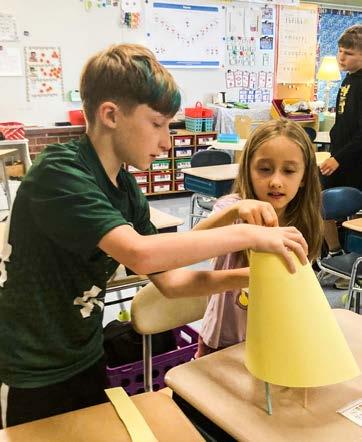

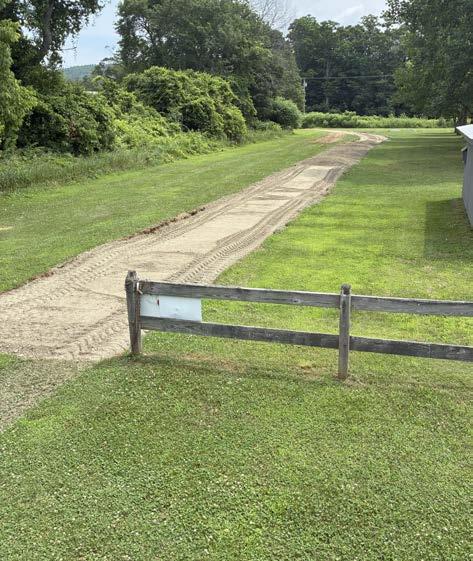

after months of fundraising and years of dreaming, the Dummerston school Walking trail is complete! if you came to a bingo night, bought a raffle ticket at town meeting, participated in the Fun run, donated on goFundMe, or sent a check to the school, you made this happen! We have had 150+ community members that have contributed in some way. We showed that it truly does take a village to make dreams happen–Thank You! a very special thanks to our two major donors, Dummerston school graduate tim Knapp and arborClimb tree service, and to the Dummerston rec board for hosting the Fun run this past spring. We also want to especially thank the Dummerston 7th grade class who raised more than $13,000(!) through hot dog and bake sales, school dances, and solicitations of local businesses. your hard w ork in service to your community is truly inspiring.
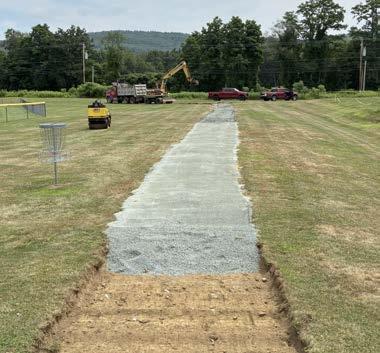
The Dummerston Middle School soccer season is in full swing this fall! We are excited to have a large number of student athletes this season and to be able to field two teams! Keith Marshall and Kelsey Parker are serving as head coaches, while Jamie Capan is assistant coach.
in recognition of hunger awareness Month in september, the Dummerston school asset team and Dummerston Cares worked together to organize a food drive to benefit the Putney Food shelf. Dummerston school asset team members promoted the food drive during the september 18th all-school meeting and invited members of each class to fill food drive boxes that they had specially decorated for this purpose. the Dummerston school asset team, advised by school social worker seth o’Connor and school counselor nicole thomas, serves as our middle school leadership team and works to develop leadership skills among middle school students as well as strengthens relationships and connections among our whole community. thank you to everyone for donating to this food drive in support of the Putney Food shelf which serves a growing number of local families throughout Dummerston, Putney, and beyond.
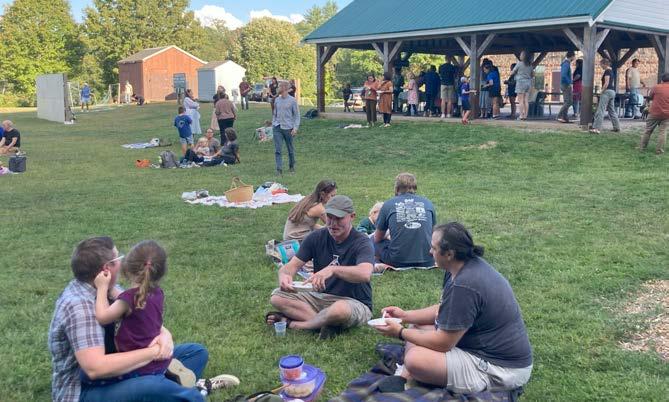

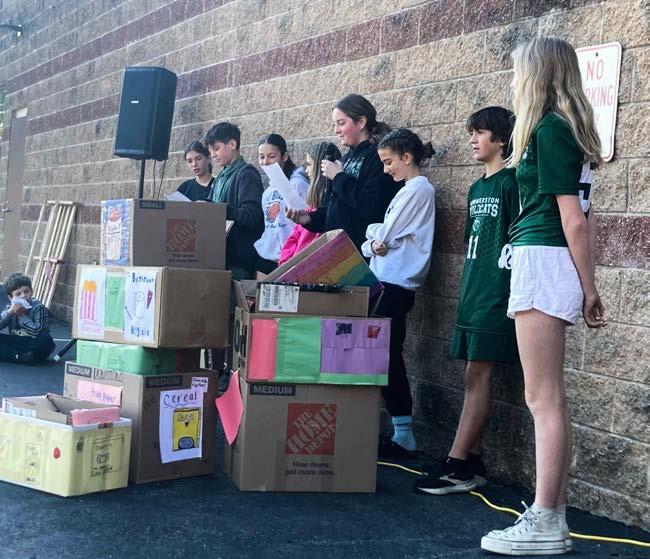
the annual ice cream social, hosted by the Family involvement team and Dummerston school leadership Council (DlC), has become one of the special ways Dummerston school rings in the new school year. each year, families bring a picnic dinner to enjoy on the playground and then are treated to ice cream with a lot of fun fixings. over 100 members of our school community came together for this annual tradition on the evening of september 3. thanks to the Family involvement team and the DlC for hosting this wonderful event!

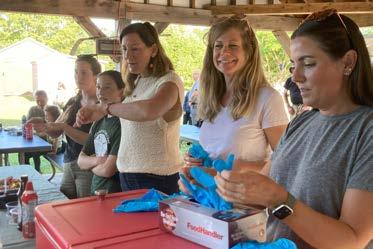
We are excited to share that Vikki Johnson and Jasmine bernier have returned to Dummerston s chool as members of our Dummerston s chool n utrition team—this time as district employees! For the first time in many years, our food service program will be administered as an in-district program, rather than contracted out to a third party. as a result of this shift, students have been enjoying nutritious, delicious meals that feature many foods harvested from area farms. h omemade pizza dough and tomato sauce, homemade granola, and an abundant salad bar with a vast array of vegetables and healthy protein options are just a few examples of the changes we have seen. We are so grateful to have Vikki and Jasmine heading up this important work and fueling our students’ bodies and brains with healthy and delicious food!

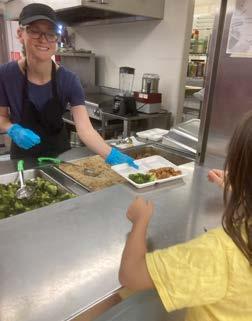
By Julianne Eagen
Dummerston School students were greeted by some new faces on the first day of school. Please join me in welcoming the following new staff to our school community:
Julianne Giordano, Elementary Paraeducator
Technically, we are welcoming Julianne back to Dummerston! Julianne served as a special educator at Dummerston School from 2018-2020. Since that time, she has worked in the field of early childhood education, first at Wonder in the Woods in Dummerston and then at Guilford Center School in the PreK program. Julianne is working on obtaining her early childhood endorsement.
Logan Snow, Third-Grade Teacher: Logan comes to us with eight combined years of experience in kindergarten, first, and third grades. She has a Master of Science degree in Reading and Literacy Instruction. Most recently, Logan served as third-grade teacher at Oak Grove School in Brattleboro, VT.
Claire Holmes, Guidance Counselor I’m excited to share that School Counselor Nicole Thomas will return to Dummerston School three days per week. In other excellent news, we have hired Claire Holmes who will work two days opposite Nicole. Claire is a recent graduate of Vermont State
University with a major in Psychological Science. As part of her program at VSU, Claire interned at Spring Lake Ranch, a therapeutic community in Cuttingsville, VT. During her time as an undergraduate, Claire also worked as an assistant PreK teacher at Beaver Brook Children’s School in Wilmington, Vermont.
Kaylah Hemlow , Intensive Services Interventionist
Kaylah has over ten years of experience working with children—first as a child-care provider in a licensed, in-home child care program, and then as a teaching intern in a number of contexts, including early childhood classrooms and intervention service settings.
Josh Maiocco, Technology Assistant
Josh has a wealth of experience as an educational technologist in a number of area schools. Most recently, he served as first point-of-contact for all technology support at The Putney School. Prior to his time at The Putney School, Josh worked with students and staff to meet all of their tech-related needs at Kurn Hattin and then Landmark College. Josh is also an avid guitar player who provides lessons for people of all ages.
Melissa White, School Nurs e
Melissa comes to us with 33 years of nursing experience across a range of fields,
By Julianne Eagan
Thursday mornings at Dummerston School are dedicated to activities and programs that build connections across and among grades, and provide an opportunity for us to enjoy and celebrate our school community. These Thursdays, called Community Thursdays, each have a special focus. For example, on the first Thursday of each month, families are invited to enjoy coffee and treats under the pavilion (or in the lobby when the weather turns cold) and then stay for our All School Meeting. At the All School Meeting, music teacher Mr. Evans leads us in the greeting song and then students from a designated class take over the meeting to teach us a game or support
us in participating in an activity together. All School Meetings are also a time when we appreciate students for demonstrating their commitment to our Social Contract with a special maple leaf or red apple that gets displayed on the painted tree outside the library. Musical and theater performances, by students and by a variety of community groups. are also part of our All School Meeting tradition.
Another activity that takes place on Community Thursdays is buddy classroom time. Each month, buddy classrooms get together for learning activities and projects; this allows older and younger students to forge a special bond that unfolds and strengthens throughout the year.
including school nursing, pediatrics, and labor and delivery. Since 2022, Melissa has served as school nurse at Guilford Central School. Melissa has also been serving as a dedicated member of the Dummerston Leadership Council over the last several years.
By Julianne Eagan
The Dummerston Leadership Council is a sub-committee of the Windham Southeast School District Board whose purpose is to act as a liaison between the school community and the board and to partner with the administration and staff in support of student learning at Dummerston School. The work of the Leadership Council is governed by school district policy and can include the following activities:
• Supporting inclusive community-engagement activities.
• Communicating community values and expectations to board.
• Assisting school board in development of school-based goals for student learning based upon community values.
• Reviewing student learning needs and progress measures.
• Assisting in initial budget development.
• Reviewing resource priorities.
• Providing feedback on policies and procedures.
• Providing input in hiring processes.
• Supporting school and district communications.
• Providing input on learning initiatives.
• Coordinating local school committees and organizations.
The Dummerston School Leadership Council is made up of staff, student representatives, and community members. Members currently include: Michelle Green, Jessica Nelson, Kim Lane, Carmen Carone, Rick Bryck, Melissa White, Hannah Van Loon, Julianne Eagan, Emily Wagner, Christine Bricault, Caroline Picker, Lance Neeper, Maeve Jenks, and Deborah Stanford (WSESD Board representative).
We welcome all community members to join our monthly meetings! Meeting agendas and minutes are posted on the school and district websites.
By Dena Marger
Wow! What a summer it was at the library. We didn’t stop to catch our breaths once! With the addition of children’s library staff Stacey Kripp, and our expanded open hours, we were able to offer a full slate of summer programming from June through August. We had weekly Summer Camp Arts and Crafts. We had weekly programming for babies at our Sensory Playtime group. We had a weekly Picture Book Storytime program. We had a weekly building blocks program! I’m exhausted just thinking about it all! We also had a bunch of special events. We kicked the summer off with a carnival that included a fun bouncy house and a visit from Trevor the Games Man, and finished up with a fabulous storytime event with Stephanie Phelan of Fizzical Fairytales, who delighted our audience with a theatrical retelling of the King Midas story.
With Stacey coordinating our children’s programming, we were also able to start building up our adult programming. Dummerston residents have really enjoyed coming to meet neighbors at our weekly coffee chat program. We’ve been thrilled to be able to offer event passes to the Next Stage Bandwagon Outdoor Concert series all summer long. And our library Book Club and our Cookbook Club cruised along all summer, and concluded with our really fun Parking Lot Tailgate Bar-B-Que party!
Because of the support of Lydia’s Friends, our friends of the library organization,
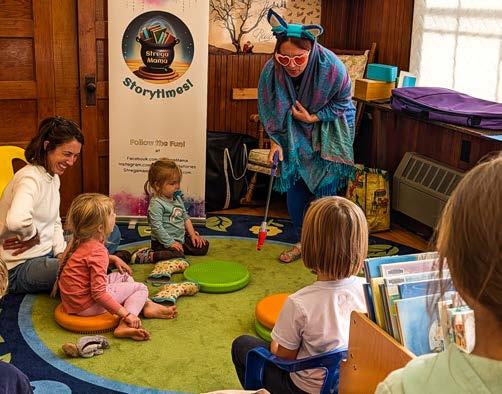
By Catherine O’Callaghan
“I have always imagined that Paradise will be a kind of library.”
Jorge Luis Borges
Lydia’s Friends serves as the friends-of-thelibrary group for Dummerston’s Lydia Taft Pratt Library. We are committed to promoting the success of our town library located in the Dummerston Community Center at 150 West Street.
This summer we have continued hosting events. The grant we received from United
her celebrated books, focused on helping kids to recognize the ways they do have power in their lives—the power of their inner strength, the power of connection, the power of a question and the power to live fully. Those who attended left with signed copies of a book of their choice generously provided by the library.
Then on a balmy evening young and old gathered in the field in front of the Dummerston Community Center and Library for a night of insect observation and community science. Our guest was Louis Burns an educator and naturalist for the New York City Parks Department. He taught us how to use the iNaturalist app to document our observations and contribute to a growing community of scientists. Some of the most fun this night was had by the children capturing images of moths in the light trap.
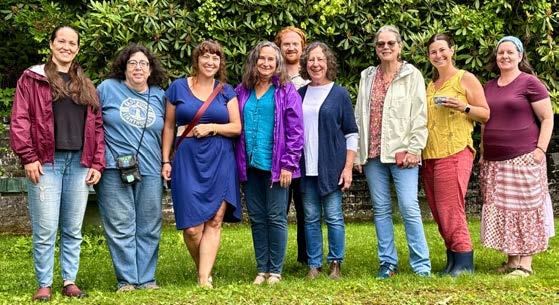
for Libraries funded two more speakers in our Ecological Speakers series. We were lucky to host Ann Braden in one of her final presentations before she returned to school this year. Ann’s inspiring slide-presentation, drawn from
We also were delighted to host a book launch for Dummerston resident Peter Thurrell who recently published Badji’s Tales: Living with Faith in the Invisible (Green Writers Press). The audience was riveted as Peter read stories recounting his life. Peter’s storytelling has the rare ability to embody both humor and gravitas. Although his publisher had advised him to only read for fifteen minutes because of short attencontinued on page 16
we were also able to offer museum passes to the Vermont Institute of Natural Sciences, the Eric Carle Museum, the Magic Wings Butterfly Conservatory, and the Montshire Museum. (These are available all year long, and you should take advantage of them!!!) We were also able to co-sponsor a number of fascinating presentations with Lydia’s Friends this summer, including a visit from Brattleboro author Anne Braden, who discussed her latest book, Into the Rapids, and naturalist Louis Burns, who led us through a fascinating evening of citizen science and insect observation.
And, if that wasn’t enough, we brought about the transition from our former library software to our new membership in the Catamount Library Network. Membership in the Catamount Network means that all our library users can request materials from other network member libraries simply by visiting our online catalog (big link on our website: dummerstonlibrary.org) and clicking the blue PLACE HOLD button. Sound complicated? It’s not! Stay tuned, because we will soon be offering workshops on how to use the library’s online resources, including our website and new catalog, our access to ebooks and audio books via OverDrive/Libby, and our Vermont Online Library database collection.
Throughout the fall and winter, we will be looking to host more authors, speakers, and films, and we’d love to hear your ideas about what kind of programs or speakers you’d enjoy hearing from. We’ve also resumed our satellite library service to the Dummerston Cares twice-monthly senior luncheon at the Evening Star Grange. So stop by the senior luncheon to check books out or return them. No need to cross the bridge to return, even if you aren’t having lunch. Just stop in!
If you’re thinking it doesn’t seem possible that continued on page 17
By Bill Schmidt, Dummerston Cares
Dummerston Cares partnered with the Dummerston School in September in a successful, firstever food drive for the Putney Foodshelf. Thanks to an outpouring of support from hundreds of Dummerston residents, Cares’ volunteers delivered 1,600 pounds of food and supplies as well as checks to the Foodshelf, which exceeded the goal. The food donated included a variety of staple foods. It will be given to those in need in Dummerston and neighboring towns, as the Foodshelf welcomes shoppers from the surrounding area.
The school’s participation included
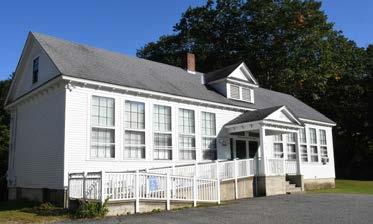

enthusiastic support and leadership from the Dummerston Middle School ASSET team that worked with younger children in letting parents and others know about the need for donations. We thank them for their leadership!
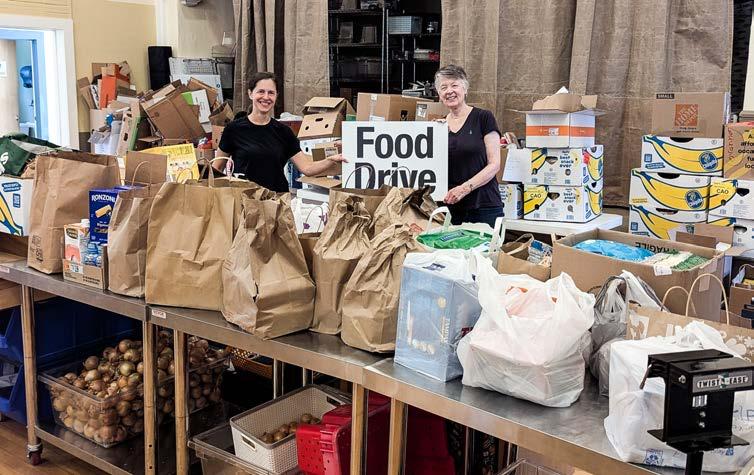
In the year between July 2024 and June 2025 there were 457 visits from Dummerston households to the Foodshelf. Included in this count were 20 households that shopped for the first time. If you count the number of people in each household, food was provided to 1,451 Dummerston residents. Increasing numbers of people seeking food, coupled with the increasing cost of food and less free food available in the charitable food system, means that the Foodshelf needs to purchase more food than ever. More support in contributions is therefore needed to make the purchases.
The Foodshelf is open on Fridays 12:303:30 p.m. and Saturdays 9-10:30 a.m. People are invited to shop weekly. Nourishing staple foods are available, including milk, produce, meat, eggs, and other basics, including diet-specific options.
Dummerston Cares is also supporting the Foodshelf’s request for $3,000 from Dummerston to pay for the cost of food and general operational expenses. If approved by voters at the 2026 town meeting, Dummerston will join Putney, Westminster, and Brattleboro in support of the Foodshelf.
We assure you that our collective generosity as a community will have an immediate impact on the Putney Foodshelf’s ability to provide healthy food for our neighbors. At a time when the need continues to increase, your support will truly make an important difference. Thank you so much.

Debbie & Dennis Baker
Eleanor & Charles Fish
Teri Robinson
Barbara & Milt Gilmore
Sallie May
By Roger Turner
On Tuesday afternoon, August 16th, Chip Greenberg was working on a project in the basement of the little house he recently built on Miller Road between his home and the Miller Orchards packing house. Out of his westward-facing windows he was keeping an eye on a cloudy sky, threatening rain. He began to notice a “rushing” sound and thought that the rain had begun, though looking out the windows he didn’t see any. So he opened the basement door and was astonished to see, only about 300 feet away, the packing house fully engulfed in flames. “The flames were so strong and so high—maybe 20 feet above the roof of the building, just coming right up through the roof. When I think about how the roof was clad in metal, I don’t know in retrospect exactly what I was seeing, whether the flames were wrapping around the edges of the metal roof or that portion of the roof had blown off or melted. I could barely see the frame of the building. I’ve never seen anything like it and I was in shock.” Chip quickly realized he needed to call 911, which immediately transferred him to the Fire Mutual Aid dispatcher in Keene for what was their first call about the fire.
was one brush fire across the street and embers were traveling miles up the road. All in all, with the third alarm we ended up with four additional tankers,” Larry reported. Chip told me
have done anything except stand back and put water on it. It was just one huge fire.”
“This was the largest fire in the area in 20 to 30 years, minus the Brooks House fire and downtown Brattleboro fires. That’s one thing that a lot of people in the fire service keep saying. It was definitely a large-scale incident for the area,” Larry continued. “We kind of faced at one point that we weren’t going to save the building. To effectively put out that fire, you would need 3500 gallons per minute dumping on it. That would be six ladder trucks shooting water. So we switched to saving everything else around it. Like the orchard—we kept putting our water on that. But our focus definitely changed to conserving what we already had saved.”

that friends who lived a mile and a half away in Putney found chunks of what seemed to be charred plastic foam fallen into their fields that evening. The sheer size of the fire caused him to conclude that though the response by all the fire departments was overwhelming, “even if the fire department had been there in one minute from the time I saw it, they couldn’t
The water needed to fight the fire came from the pond just north of the Bunker Farm, which has a dry hydrant. “The tanker trucks would leave the scene, go north on Miller Road, and over to Bunker. Once loaded with water, they’d go out Bunker Road, down East West Road and come back up Miller. So it was just one continuous circle. Once we got water supply established on scene, we never ran out of water. It took nearly 30 minutes to get water up and established, but continued on page 18
“So I described the scene and said the building was fully engulfed and gave them my number. It took the fire department about 20 minutes to arrive. I realized with a volunteer fire department you have to get the people from wherever they are to the firehouse and then they have to drive to the fire. Even though we’re close to the firehouse, it’s still a six or seven-minute drive. So when you add all that up, 20 minutes is not a long time, but it seemed like a long time. It was 3:15 when I called it in.”
The fire response began as a one-alarm call. Putney firefighters are always notified of onealarm fires in Dummerston. “Upon getting to their station the Putney people reported they could see a large column of black smoke and they asked us what we’d like to do,” Dummerston Fire Chief Larry Pratt, Jr., recalled. “So we bumped it to a second alarm which brought in several more trucks. And then we got on the scene and realized it was beyond a second alarm, so we went immediately to a third alarm which ultimately was responded to by departments from fifteen towns. The danger was not just the building. Everything was so dry. There
By Martha Miller Grace
On August 16th, the core building of Dwight Miller Orchards burned to the ground. The fire was presumably caused by the area lightning strike recounted by several witnesses. The multi-season, multi-function building was part warehouse, part commercial food processing center, with a retail shop and informal museum housing agricultural tools, heirlooms, and family photos—some indispensable, and many irreplaceable. The central “packing house” facility was built in 1962 by my grandfather Dwight Miller, Jr. on a piece of land that had previously been used for horse pasture, due to a ledge of bedrock that prevented a higher agricultural use. Originally designed to stretch 100 feet, the cost of the fill required to level the ledge, among other things, trimmed the building’s footprint down to 75 feet. Still, it was a massive slab. Sue Miller recounts some details of the original construction in remarks delivered at the 1991 celebration, after Read
Miller completed the addition of the controlled atmosphere (“C-A”) storage rooms capable of storing 34,000 bushels of apples.
“In 1962 the first storage was built here, delayed a year by a hailstorm. It was do-ityourself construction and one of the critical tools was a little orange battery-powered Lewis-Shepherd forklift. It was used to lift the steel girders. I was seven when the building was built, and Read was three. Our childhood footprints are imprinted in concrete in two places. Dad showed me a place in the foundation of the cold storage where there was a place to make a door and he said that in ten years there would be a C-A storage there.
To christen the new building, a square dance was held in what is now the packing and sales area. Ted Glabach called for it. Donuts and soda were served. That ten-year estimate was about 20 years off. Twenty-nine years later, Read has built that C-A storage. The door is where Dad said it would be. The little orange continued on page 19
By Linda Rood
What does the concept of “summer reading” mean to you? Traditionally, I guess it was supposed to be beach reading, or vacation reading, not-so-serious reading when the days are lazy. That idea seems outdated to me now that my life is not organized around my schoolteaching year, and summer isn’t a big open space on the calendar and life doesn’t really slow down much. I spent the better part of July reading two fairly large works of non-fiction, and found some wonderful small novels later in the summer. This year, my “summer reading” yielded some fine discoveries, but I wouldn’t describe them as “beach reads”.
My book group read An Unfinished Love
By John Anderson
Today I looked and where my hands should by rights have hung I found instead my grandfather’s hands.
Lean, knuckly, Ropey veined, a bit tanned with fragile, work scarred old man skin.
Hands I last saw sixty some-odd years ago.
Not by rights my hands, I thought. Shoplifted hands, perhaps. Hands slipped into my pockets when no one else was looking. Hands spirited away from their rightful owner, or picked up in some thoughtless moment.
Not my hands surely. But there they are in my possession irrefutable. My grandfather’s hands, not my hands.
Having misplaced my own hands someplace, I find them useful, if a bit foreign, and somewhat clumsier than the pair I once employed.
Story: A Personal History of the 1960s (Simon & Schuster, 2024), the newest book from Doris Kearns Goodwin. Goodwin’s husband, Richard Goodwin, was a speechwriter for both John F. Kennedy and Lyndon Johnson. He was also instrumental in the establishment of the Peace Corps, and played an important role in the presidential campaigns of Eugene McCarthy and Robert F. Kennedy. He was the author of some of the most important and powerful political statements of the 1960s, words that are familiar to those who lived through and remember those times. He is perhaps one of the most important figures of those times that nobody has heard of. It turns out that Goodwin saved everything he had from his career in 300 boxes full of documents, drafts, and souvenirs. In 2011, when he was 80, Richard and Doris started to go through the boxes, and the book was born. Doris was a fellow in the Johnson White House, became close to the President, and was asked by Johnson to write his biography. A major point of discussion between the husband and wife, and throughout the book, is the question of which president deserves the most credit for the landmark legislation that was accomplished in the 60s. The loyalties of Richard and Doris were sharply divided on this topic, which makes for tension and lively debate between them.
This book is part memoir, part history, part biography (of Richard Goodwin), and part the love story of a marriage. If you lived through those times, the book will bring back powerful memories, and fascinate you with the intimate details of the inside stories of the great events of those presidencies. I predict that it will move you to tears, and perhaps renew your admiration for the greatness of spirit that brought us the monumental changes of those days: civil rights laws, voting rights, fair housing policies, public television and radio, and more. The parallels and contrasts between those times and now is startling. It’s a great book. Everyone in my book group felt the same, which is a rare event! Orbital by Samantha Harvey (Grove Atlantic, 2023) is a slim novel (only 136 pages) that was the unanimous winner of the 2024 Booker Prize. It describes what it is like to spend 24 hours on an international space station orbiting the Earth.
B ad G oose F arm & N ursery
Heirloom Trees and orcHard

~ www BadGooseFarm com ~ Grow your own heirloom apples!

50+ Apple Varieties Houghton Road, Dummerston Pruning • Orchard Planning + Restoration
I had avoided this book because I thought I wasn’t interested in a novel about astronauts, but I picked it up on the recommendation of a friend. I was captivated immediately by the beauty and mystery of this story.
Six astronauts go through twenty-four hours of travel, in 16 chapters, each chapter covering a single 90-minute orbit of the Earth, 16 sunrises and 16 sunsets in one 24-hour period. They are four men and two women, representing Japan, the UK, the US, Italy, and Russia. We follow the details of their assignments on board, and we read of their reflections as they travel. We learn how they live, preparing dehydrated meals, sleeping in a gravity-free environment, and exercising to prevent their muscles from atrophying. We also witness the thrill of space walks and the wonder of watching continents pass beneath as they hurtle through space. On this particular day they are watching a typhoon forming in the Pacific, with a mix of awe and fear for those below.
There is minimal plot, but we do see the characters and their relationships emerge as the hours pass. We experience their individual reflections on humanity, their ties to the Earth, and the beauty they see. The author watched a live stream from the International Space Station as she wrote, and she relied on the work of Carl Sagan to back up her imagination. It is a remarkable book, deemed “ravishingly beautiful” by the New York Times reviewer. Sara Collins, a judge for the Booker, said that the book transported her from the many crises on Earth and re-framed these crises, and humanity, in a new relief. She said, “This is a book we need now, but it may also be a book we’ll need forever.” I also very much enjoyed and recommend Small Things Like These by Claire Keegan (Grove Press, 2021) and Peace Like a River by Leif Enger (Atlantic Monthly Press, 2001). And in case you missed this, book number five of the Richard Osman’s Thursday Murder Club series, The Impossible Fortune was published on September 30th .
The Winter edition of the Views is coming up next, and I plan to continue the practice of soliciting book suggestions from you, the readers of Dummerston. Please think about the books you enjoyed the most in 2025, and share your list of two or three with me. Send your thoughts to me at turood802@gmail.com And thanks!
Compliments of Priscilla Svec, P.T.
Practicing Holistic Physical Therapy 126 Main Street, Putney 387-4799
continued from page 2 worked until his retirement in 1999. A couple of years after starting work at the WRC, Lew and his wife Gail bought a house in Dummerston, and after retiring from the WRC and while working part-time for the Center for Disease Control traveling throughout New England, Lew had time for volunteer activities including driving for Meals on Wheels, and ushering at Weston Playhouse and the Dorset Theatre Festival. He also became active in Dummerston governance as a member of the United Way allocations committee, the Development Review Board, the Zoning Board of Appeals, serving as a Dummerston representative to the Windham Regional Commission, and was elected a Justice of the Peace. He enjoyed working at the polls on election day, “because he got to put names with the faces of people he hadn’t met before. It was an opportunity to reestablish contact with people that he had met in various capacities, and he also just got to see old friends,” Gail observed.
And why did Dummerston come to feel like home for the Sorensons? “We have one daughter who lives in Brattleoboro, but the rest of our family is in the Midwest and we actually have a relatively small family at this point,” Gail explained. “So people in Dummerston really got to be our family. When Lew was ill, people were there to help us however they could. When I had surgeries, people were helping. People in this town are there for each other. You just need to let your needs be known, or at least be accepting of people asking questions.”
She continued: “I think there are opportunities to really get to know people, to help them out when they need help and for them to help you out and share with you. So our lives are more intermingled. I think I was probably a little bit more social than Lew. He was quieter, but he was there for people. I can’t remember the year but Jack and Margit Lilly, who lived across the street from us, and Lew and I were going to have a neighborhood party at our house, but Jack was going to deliver invitations to people. So I ran off a number of flyers that he could put in people’s mailboxes. The deal was
we were inviting people along Middle Road, from Route 5 up to the Center, because we both lived here on Middle Road. Well, Jack came back and said he needed more invitations. On the night of the party people started knocking at the door and people showed up that I had no clue who they were. Jack had delivered invitations up and down East-West Road. He went up Park Laughton Road and Bunker Road, and he went down Dutton Farm Road. Over the course of the evening we probably ended up with over 70 people, though they weren’t all here at the same time. People brought their kids and it was kind of a pot luck. They were sitting on the stairs in the house, stairs in the hallway, and on the deck. It was wonderful and
it was the opportunity to get to know people. So people do respond to warmth and invitations and sharing. And it’s easy to reach out and it’s easy to get involved and you can do it without getting nosy.”
Lew joined the Monday night cribbage club when it started up, and was also part of a Wednesday morning men’s coffee group. His published obituary concludes: “Although not initially knowing anyone in the towns where he accepted new employment, Lew appreciated learning about the areas and being part of the community. His last move, to Vermont, was the move where neighbors and friends became like family. It was home!” And here in Dummerston he became just Lew, rather than Colonel.
continued from page 2 corner of Route 5 and Houghton Road, where she grew up. We frequently played together at her home or mine—after all it was only a little over one-half mile between the two and we hardly ever saw any cars. The road was so washboardy we could have outrun them anyway!
My folks’ house was really a camp, with no running water or inside plumbing. I remember well the day Ruth came bouncing up the driveway while my father stood at the kitchen sink, in his skivvies, shaving. I remember saying “Dad, Ruth’s coming!” and his reply was, “Well it’s my house and I’ll stand here if I want,” and kept on shaving. How embarrassing! Ruth came through the door, barely glanced at him and said something to the effect I should come over because her grandmother was baking cookies! I was out the door in a flash and waved good-bye to my mother who was working in the garden. Another favorite memory was sitting in her room “doing homework.” She was practicing her shorthand, and I was reading a book and watching her make all of those beautiful lines. What fun, I thought. When I finally got to high school, one semester of short-hand taught me that there was no fun in it and I immediately signed up for typing!
Once Ruth was out of high school she married and moved to Putney, and I sort of lost track of her for a number of years. She would call me from time to time when she was at her grandmother’s, and I would go over if I had time, but once her mother died and her father’s health began to fail, she was at the house more often. By then I was married with two kids, and she was divorced and remarried. One day we reconnected at a daycare center where we were both registering our children for daycare. She was moving back to Dummerston to help take care of her father, and I was living in Guilford
but still going to church in Dummerston. We saw each other more often, but it wasn’t until after my husband passed in 2006 and I became more involved in the workings of the church that we really rekindled our friendship. She was a former Grange member and I am a current one, so while she never rejoined the Grange, she would shop for things we needed at BJs, help out with special functions and events, take money for our senior lunches, and was someone I could always call for advice or information. She knew many, many people and could remember more three days before her passing than I ever would. She was also the backbone of the church Caring and Sharing Program, and the Apple Pie Festival, and got me involved in both of these activities. While others were leaders of the Pie Festival, she was the one who “got-er-done”, ordering supplies, keeping track of volunteers, making sure things were in their place, mixing spices and sugar, and also running a “doughmaking Friday” to be ready for the start-up of pie making on the last Monday in September. It makes my head spin just to think of it.
Ruth was a great story teller and reader. She had a real Vermonter’s twang and could broaden it out when agitated or excited. I loved to hear her read the scripture at church, her voice was strong and the expression she could put into her reading was wonderful. One day she wondered aloud if a local lady who was going blind would like someone to read to her. I said it was certainly worth asking, and so she began going to the lady’s home and reading to her once a week. They both enjoyed it so much and when Ruth got sick and could no longer do it, she really hated to give it up.
I wish every day that I could pick up the phone and hear her voice on the other end. I miss Ruth, but I am sure we will reconnect again someday.
By Alex Wilson and Peter Grose
An enthusiastic crowd of about 80 people gathered for the official opening of the new White Oak Trail, the first trail established in the Green Mountain Conservancy’s Canoe Brook Preserve, on September 20, 2025. Three generations of residents, students from the Putney School, and other friends, gathered to celebrate the event on a beautiful fall morning. Clearly the town of Dummerston has a wonderful addition to its already impressive collection of walking trails!
The new trail is approximately half a mile long, and leads to three huge, ancient white oak trees. One of these trees is the secondlargest white oak in Vermont! The trail was laid out by Roger Haydock, who is wellknown in southern Vermont for his skill in designing trail routes that bring travelers to see the special features in an area while gently meandering along the ups and downs with limited impact on the existing land.
Mary Ellen Copeland, president of the Green Mountain Conservancy, opened the program, thanking the people involved with establishing the Canoe Brook Preserve and those who laid out and prepared the White Oak Trail. The plan is to develop a longer, Loop Trail in the future. She also provided an update on other GMC preserves, including the Deer Run Nature Preserve that lies in Dummer -
ston, Newfane, and Brookline, and a 250-acre preserve GMC hopes to purchase in Newfane. She also introduced Leigha Allen, the GMC’s first executive director.
Roger, an amateur geologist in addition to trail-builder, provided a brief and fascinating introduction to the geology of the Canoe Brook area. His keys to the story were time travel and Tums. One needs to go back 450 million years, to when the land on which we stood was at the bottom of the ocean, to understand the land. As the earth’s crust shifted, it squeezed together and created ridges and troughs, with some of the ocean bottom folding from horizontal to vertical. Roger pointed out that some of the rock was largely calcium carbonate (that’s where Tums came into the picture), while some was much harder rock. The hard rock remains as the many ridges we see in southern Vermont, including at Canoe Brook, while the softer rock eroded away, with its calcium carbonate serving as good substrate on which our fields and forests grew.

Gordon & Linda Evans
Heather & Gene Rostov
Akara Draper & Linnie Jones
Elizabeth Catlin & Jared Flynn
Cliff Adler & Lynn Levine

The opening festivities included hikes on the new trail to see the ancient white oaks. The vast majority of the attendees chose to take the “geology walk” with Roger, their appetites whetted to learn more about the geologic history of the area.
The Green Mountain Conservancy, a nonprofit, 501c3 organization based in Dummerston, is currently working to raise funds for the purchase of an extraordinary property in Newfane Village. This 250-acre property is being sold to GMC by conservation-minded owners to keep the property open to residents who have long used trails on the property.
Of the $749,000 project cost, 81% has now been raised, much of it from the Vermont Housing and Conservation Board and The Nature Conservancy. You can learn more and donate on the GMC website: www.Green MountainConservancy.org.
Alex Wilson and Peter Grose are members of the Canoe Brook Stewardship Committee, and Alex serves on the Green Mountain Conservancy Board.
continued from page 11 tion spans, the audience kept asking for more as he read for an hour, then signed and sold books.
Our treasurer, Sam Bledsoe, has made a connection with BCTV and is now filming our events. Check out these links on the BCTV website (brattleborotv.org/videos): Ann Braden: On Writing & Activism , and Peter Thurrell Reads Selected Stories
Finally, we were chosen to partner with Scott Farm to participate in Crepe Night. Blessed with wonderful weather, ten energetic volunteers, and a sold-out evening, we raised $920 for our town library. These funds were specifically designated for the library’s popular museum pass program. We are grateful to Scott Farm for their dedication to our community endeavors. Lydia’s Friends meets the second Thursday of the month at 5 p.m. in the library and all are welcome. As a new nonprofit, we are actively recruiting members and welcome any level of involvement because no contribution is too small. If you are interested in helping out, call Catherine O’Callaghan at 802-380-7935 or email catherineocallaghan32@gmail.com.
By John Anderson
Every once in a while, I encounter something that totally defies my expectations— something truly unique, something that expands my perspective. So, it was with the caterpillar commonly known as the monkey slug.
The vast majority of caterpillars are vaguely sausage-shaped, have either legs or protolegs on most body segments, and have a head segment just distinctive enough to be identified as such. Colors vary. Some species have spines, tails, horns, hair tufts, or knobs. Some are larger, some smaller. However, the underlying Lepidopteran larval form is fairly simple: a sausage with legs. Any preschooler with a crayon can draw a recognizable caterpillar.
The monkey slug, the larva of the hag moth (Phobetron pithecium) is a notable exception. It is the most uncaterpiller-like creature imaginable. The Guide to Caterpillars of Eastern North America says simply and succinctly that the monkey slug is “unique.”
A full grown monkey slug is about one inch long. It’s brown, hairy, and has six long
continued from page 11 we could do all this with just one half-time staff and another quarter-time staff, well, you’re right, it isn’t. Luckily, we have a number of amazing volunteers who help us out, including those who participate in Lydia’s Friends as well as our library trustees, who are all volunteers. If you have any special skills or talents that you’d be interested in lending to the library, we’d love to hear about them. If you have ideas about what you’d like to see your public library do for you, stop in and let’s discuss what might be possible. A seed library? A tool library? Would you borrow a bike from the library if we had them to loan? A cakepan? Would you want to volunteer to help make a program like that happen? The sky’s the limit!
Write for the Views
tentacle-like ‘arms’ and another six that are somewhat shorter. A kindergartener’s crayon drawing of one might resemble a cross between a small furry mammal and a cephalopod. It would in no way be identifiable as a caterpillar. At least by most.
I wanted to learn more.
According to my research, “the ‘arms’ of this caterpillar are deciduous; caterpillars often have missing or shortened lobes.” Classifying body parts as deciduous was in itself jarringly unique.
The northern range limit of the hag moth, and therefore of its larva the monkey slug, is Maine and southern Quebec. They are more common in the southern parts of their range.

from time to time.
Food for this caterpillar is listed as the leaves of apple, ash, birch, cherry, chestnut, dogwood, hickory, oak, persimmon, walnut, willow, and many other woody shrubs and trees.
Sadly, all of my exposure to the monkey slug has been secondhand. Two alert and curious acquaintances have found and photographed specimens and shared those pictures with me. Thankfully both parties had already identified the creature in their picture as being the caterpillar of a hag moth. They sure didn’t look like any caterpillars I had ever seen. They were not the sausages with legs that I would have expected.
This caterpillar is unique. Although clashing with my expectations it was fun to learn about. It was also a reminder that absolutely nothing in the world is constrained by our expectations. Such reminders are needed
We appreciate people taking the time to write something about our beloved town, so please consider becoming a correspondent. Email articles@ viewsofdummerston.org

In all honesty, prior to learning about this species if some crayon-wielding preschooler had presented me with a drawing of one I would probably have deemed that child to be wildly over-imaginative. Now I know that the monkey slug is not made up, it’s simply unique. One of a kind. Not only does it have octopus-like arms, those arms are deciduous. A caterpillar! I would never have imagined!
Peter Hubert Cairns
6/25/25
Derrik C Hoitsma, Jr. 7/12/25
Stuart Walker Hunt, II 7/19/25
Ruth H. Barton 8/8/25
Larrimore Crockett 9/10/25
Eleanor Emery 9/30/25

continued from page 13 once we did, it was just steady. We had water when we needed it,” said Larry.
Chip also recalled, “There were many small explosions from inside the building. Every five to ten minutes there was another big pop, not explosions where you could see something bursting apart, but you could hear them from inside.” Larry told me that there were all kinds
of materials on that site, from fuels to chemicals, that went up in the flames. There was a lot of vinegar, too. “They had storage tanks of vinegar. And everything in large quantities is a hazardous material. In the firefighting world spilled milk is a hazardous material.” He continued, ‘There were a few firefighters who weren’t wearing airpacks, but not from our department. Firefighters get themselves in
By Jeremy Ebersole
The Landmark Trust USA (LTUSA) is kicking off the rehabilitation of the former horse stable at author Rudyard Kipling’s Naulakha, which will be adaptively reused as a charming and unique overnight vacation rental. The loft of the large stable will be converted into a studio bedroom unit with sleeping quarters, kitchen, and views of the building’s striking cupola. The stable was constructed in 1896 for Kipling’s horses, Nip and Tuck, and was initially restored along with the larger Naulakha estate by the nonprofit LTUSA in 1993.
The Naulakha estate, including the main house, Carriage House, and additional outbuildings, was the home of the author’s family and staff in the 1890s, and it was here that the Nobel Prize winner penned The Jungle Book and other acclaimed stories. The main house and carriage house
operate under LTUSA’s preservation stewardship model and are made available to the public for overnight rental and small gatherings.
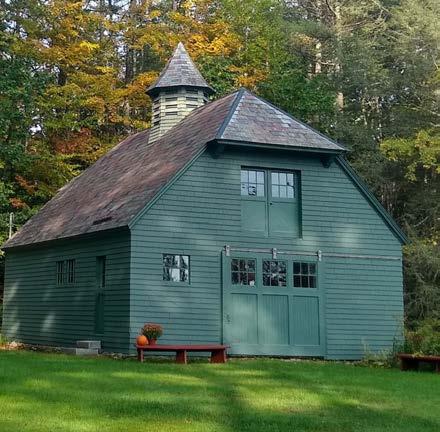

“As our first new Landmark rental in many years, the Naulakha Stable project furthers our preservation mission, ensuring this remarkable place is accessible for future generations and allowing even more people to enjoy the immersive experiences with history that a Landmark stay affords,” says Executive Director Susan McMahon. The Naulakha Stable Rehab Project is one component of LTUSA’s $1.25 million Naulakha Campaign, a generational investment in a secure future for Rudyard Kipling’s Naulakha estate, including an in-kind roof replacement at the main house and many additional buildings and an improved drainage system for the entire property. For more information, visit landmarktrustusa. org/naulakhacampaign
trouble a lot. In overhaul, which is what we call the time when the fire is deemed under control and we’re just putting out hot spots, they’ll let loose on air packs, but that’s when it’s smoking the most. You can’t let your guard down at the end. You can’t have your guard up for about 90% of the fire and then let your guard down for the last 10%. That’ll catch up to you.”
How are the activities of such a large group of people coordinated in such a dangerous, rapidly-changing situation? Because Larry was actually at his camp in Andover, VT when the fire broke out, Captain Trevor Houle, on Dummerston’s first truck to arrive at the scene, assumed command. When Larry arrived, he took over, and “just because the captain wasn’t in command anymore doesn’t mean he just jumps on a nozzle. He became my operations officer. One of my other captains was the safety officer. We had four or five department members that were participating in the firefighting activities—running trucks, pumping, and running handlines. There were four or five of us that were actively engaged in administrative tasks, orchestrating the scene.” Within their carefully delineated Incident Command System, everyone has a designated task, and because of all their training and experience, they were prepared to manage such a complicated situation. “We also had great resources on the scene that we relied on, like Brattleboro’s assistant chief was there. If I had any questions I could bounce them off him. Keene’s deputy chief was also there. For any second alarm fire he comes as part of a Rapid Intervention Team - if any firefighter goes down that is their sole obligation. They don’t do anything else but stand there and wait for a firefighter to go down. We had one firefighter who got transported for a minor injury to his hand. But, yeah, I think it was managed very well. The mutual aid system obviously worked.”
This huge fire put the Dummerston Fire Department volunteers to the test. We’re so fortunate to have so many people in town who are willing to donate their time to the training and response time it takes to serve as a firefighter. Not only do they need the skills and fortitude to fight fires, but they are also routinely confronted at fires with the anxiety and grief of those whose property, and sometimes the lives of residents and pets, are lost. “The Millers were very upset. It was unfortunate for the entire community,” Larry observed. “The Miller family thanks the courageous first responders of the Dummerston Fire Department and many area towns for their service, at personal risk, on August 16,” wrote the Millers.
continued from page 13 forklift, after lifting more pallets and bins of apples and cider than I can imagine, is still here and helped build the new building, too, along with a newer, larger machine we got several years ago.
My sense of history and tradition are pleased that the imprints of three little children’s feet are here in concrete—those of Martha, Ruthie & Will—the next generation. And we are again inaugurating our new building with a square dance—called by Ted Glabach. There’s soda, too.”
One tragic loss in the fire was a beautiful large frame of curly maple wood holding 31 early photographs (perhaps from the late 1800s? The label had worn away,) depicting maple sugaring with ox- and horse-drawn sleds fitted with large tanks made from wooden staves; some of the sepia-toned images were barely discernable from the darkening of time.
Utility was forefront at the packing house, and there wasn’t any crop or product that didn’t pass through that building at some stage of its harvest (apart from pick-your-own). Besides agricultural output, countless neighbors and visitors passed through as customers and employees. Over 60-plus years many women and men from the community worked running the cider press or packing apples. At first, sorting apples took place directly from the orchard-run bushel boxes which entered the building on a waist-high track of rollers. Later, the fruit was washed and dried on a mechanized line which then delivered it to revolving tracks from which it was sorted at stationary work stations — state-ofthe-art for its time. Fruit was graded, and boxed for trucking to grocery stores around the Eastern seaboard or fed to the cider mill. That cider press, and the people operating it, produced an estimated one million gallons of juice which went to grocery chains, food co-ops, the Dummerston Apple Pie Festival, the Big E, and regional wineries. After the transition to organic growing methods in the late 1990s, the cider mill enabled us to add value to the fruit in the form of apple cider vinegar.
One memorable visitor, though he was not recog -
nized at the outset, was Dick Cavett. A man came into the packing house, perhaps he was checking out, and asked, “Do you get my show here?” Gladys Miller replied, “What show?” He answered, “The Dick Cavett Show.” This was probably in the 1970s and that show was late at night. Legend has it that Gladys quipped, “That’s too late for farmers to watch.”
The packing house (or storage, as I grew up calling the building) had a distinct feeling to it. Visitors would comment, “It’s like going back in time!” and I don’t think they meant just the off-hours honor system scratch pad, the lack of credit card machine, or the vintage poster featuring a sheep wearing a wool sweater. The front entrance was a heavy wooden and glass door, salvaged by Dwight Jr. from an old shop, probably in Brattleboro, but no one remembers the exact source. Getting it open usually meant trusting that it would yield when applying a little muscle. Before reaching the door, concrete steps lead past the five-foot-high tractor trailer loading dock and up the rise of the knoll, under a pear tree growing from the hillside. Through the years, the black iron handrailing along the steps, offering stability for the grown-up visitor, invited many children to dangle and play on it like a tiny jungle gym. Footfalls up those steps and the muted clang of hand-on-pipe-railing had an unmistakable rhythm. You’d be greeted inside by the woodsy smells of the heavy retail counter and the everpresent notes of sweet ripe fruit and sharp
cider vinegar. Even in the heat of summer, it was naturally cool inside as the massive slab retained the nighttime chill.
Working farms can have a threadbare look. Necessary thrift results in prolonged reuse of materials and tools, until they are well-worn or beyond. This is another aspect that made the packing house feel as if of a different part of history; the prominence there of things wellworn, a result of the habit of making do. It was not a fancy place, but its economy had a beauty to it. The massive door leading from the packing house to the apple storage rooms was big enough to accommodate a forklift loaded with apple bins. Levering the metal bar of that door’s handle out of its clasp, then leaning back on your heels to wheel the huge door wide open, you’d hear a whoosh of air and a particular squawk of hinges. There was a clang of finality when closing it. This antique, like many others, was a working feature of a working building. When we lose material items from times gone by, the loss is more than missing the function of, or the job performed by, that thing. Old things are fundamentally finite, as their era is gone and can’t be made again in quite the same way. When an antique cooler door is lost, it is not replaceable. The 1962 packing house with its 1991 controlled atmosphere apple storage can be rebuilt, but not replaced.

There is a sense that accounts such as this of loss and remembrance should finish on a future-facing, positive note. Perhaps when the mountains of charred steel and debris are removed and the site swept, the Miller family can search for signs of the small footprints in the concrete — the 1962 imprints from Sue and Read, the 1991 sets from Martha, Ruth, and Will, and Tess the border collie’s pawprint. Perhaps when we rebuild, new concrete will hold the stamp of the next generation.
The Miller family thanks the courageous first responders of the Dummerston Fire Department and many area towns for their service, at personal risk, on August 16. The family is also humbled and grateful for the robust community support of their recovery fundraising campaign.
Dwight Miller Orchards 511 Miller Rd E. Dummerston, VT 05346

Smoke Alarms & Carbon Monoxide Detectors: Dummerston Cares and WDVFD are providing and installing free smoke alarms and carbon monoxide detectors. Call the DC Message Line at (802) 257-5800 and leave your name and phone number for callback.
Senior Lunches Evening Star Grange; Second & fourth Wednesday, noon. Suggested donations: in-house meals $4 for age 60 and up; $5 for age 59 and under. Take-out $5 regardless of age. For Take-out call: 802-254-1138. Leave name, phone number, number of meals desired, whether Eat-in or Take-out.
The Front Porch Forum: online at www.frontporchforum.com
Heating assistance: Fuel options listed on Dummerston Cares website. For assistance, call Cares Message Line at (802) 257-5800. Leave name and phone number to receive a callback.
Community Center Randy Hickin 802-257-0784
Conservation Commission
Web site: www.dummerstonconservation.com
Dummerston Cares Message line & Fuel Assistance 802-257-5800, email: info@dummerstoncares.org, web site: www.dummerstoncares.org
Dummerston School 802-254-2733
Web site: dummerston.wsesu.org
Fire Chief Larry Pratt, 802-579-9494
Fire Warden Ted Glabach, 802-384-6994
Deputy Fire Warden Allen Pike, 802-258-0100
Lydia Taft Pratt Library 802-258-9878
Hours: Mon. & Wed. 10–3; Tue. & Thu. 1-7; Sat. 10–2
Web site: library.dummerston.org
Facebook: www.facebook.com/dummerstonlibrary email: dummerstonvtlibrary@gmail.com
Vermont Theatre Company 802-258-1344
Evening Star Grange
Larry or Carol Lynch, 802-310-0799
Meals on Wheels Cynthia Fisher, 802-257-1236
Selectboard selectboard@dummerston.org
Senior Solutions Carol Lynch, 802-254-2517 Springfield Office 800-642-5119
Town Garage Lee Chamberlin, 802-254-2411
Town Office Laurie Frechette, 802-257-1496
email: townclerk@dummerston.org
Veterans Assistance Contact Dummerston Cares message line or email
Views of Dummerston
views@viewsofdummerston.org
WSESU 802-254-3730
Websites: Official Town: www.dummerston.org Calendar: calendar.dummerston.org
Local Interest: www.dummerston.com
PRSRT STD
U.S. Postage PAID
Mailed From Zip Code 05346
Permit No. 61
ELECTRONIC SERVICE REQUESTED
Please note that these meetings may not be taking place at their usual locations. Please refer to the town web site, www.Dummerston.org, |for updated information.